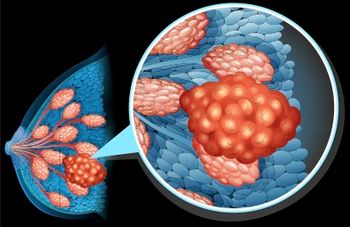
Oncology NEWS International
- Oncology NEWS International Vol 6 No 7
- Volume 6
- Issue 7
Doxorubicin Benefits Older Breast Cancer Patients
ASCO--Anthracycline-based chemotherapy should join tamoxifen (Nolvadex) as standard therapy for postmenopausal breast cancer patients who have positive lymph nodes and are estrogen-receptor positive.
ASCO--Anthracycline-based chemotherapy should join tamoxifen (Nolvadex)as standard therapy for postmenopausal breast cancer patients who havepositive lymph nodes and are estrogen-receptor positive.
The assessment came from the lead author of a study that showed significantimprovement in disease-free survival in patients treated with tamoxifenplus an anthracycline-containing chemotherapy regimen, as opposed to tamoxifenalone.
"CAF plus tamoxifen significantly delays the time to failure, comparedto tamoxifen alone in postmenopausal women with node-positive, receptor-positivedisease," said Kathy Albain, MD, of the Cardinal Bernadin Cancer Centerof Loyola University Medical Center.
No major subset could be identified that was not impacted favorablyby the addition of CAF to tamoxifen, and the benefit remained significantafter adjustment for important prognostic factors.
The findings came from a multicenter randomized trial that involvedalmost 1,500 postmenopausal breast cancer patients. In each patient, thecancer had spread to one or more lymph nodes. All the patients were positivefor estrogen receptors, and about 80% were proges-terone-receptor positive.
"In 1988, when this trial was designed, standard treatment forthis subset of patients was tamoxifen for 2 to 5 years," Dr. Albainsaid. "CMF-like regimens added to tamoxifen did no better than tamoxifenalone in most individual trials."
Three different trials had suggested a benefit of adding anthracycline-basedchemotherapy for receptor-negative postmenopausal women or for subsetswith four or more positive nodes, she said. However, in 1988, no data wereavailable on the potential survival benefit of adding anthracyclines totreatment of a pure hormone-responsive, node-positive subset. Furthermore,some investigators have been reluctant to use anthracyclines in postmenopausalwomen who might be more susceptible to their cardiac effects.
The study included patients who had undergone mastectomy for T1-3 canceror breast conservation for T1-2. None had distant metastases. Patientswith cardiac disease were excluded.
The Three Treatment Arms
The trial comprised three treatment arms: 361 patients were randomizedto receive tamoxifen at a dose of 20 mg daily for five years, and 1,109were randomized to chemotherapy with either concurrent or sequential tamoxifen.
Chemotherapy consisted of cyclophosphamide (100 mg/m² PO ×14 days), doxorubicin (30 mg/m² IV on days 1 and 8), and fluorouracil(500 mg/m² IV on days 1 and 8) for six cycles. Radiation therapy wasinitiated either before or at the completion of chemotherapy or beforethe start of tamoxifen in patients who did not receive chemotherapy.
The primary objectives of the trial were to determine whether the additionof anthracycline-based chemotherapy improves survival; whether CAF followedby tamoxifen is superior to CAF and concurrent tamoxifen; and whether toxicitydiffered among the treatment groups.
At a second interim analysis, the trial was approved for early reportingbecause one of the major objectives (tamoxifen alone vs tamoxifen pluschemo) had reached a significant difference. The chemotherapy arms werecombined for analysis, since the data to answer the sequential tamoxifenquestion were not mature.
Four-Year Disease-Free Survival
Patients randomized to chemotherapy plus tamoxifen had an estimatedfour-year disease-free survival of 79% vs 72% for tamoxifen alone (P =.001). The superiority of combined treatment persisted in the major stratificationsubsets: number of positive nodes, age, and PR status. Overall survivaldid not differ (about 85% in both groups). "It's too early to tellwhether there will be an overall survival benefit because there have beentoo few events to date," she said.
As expected, the addition of chemotherapy was associated with increasedtoxicity. However, the incidences of cardiotoxicity and thromboembolicevents were low, and no increased risk of endometrial cancer was observed.
Asked if she would now recommend anthracycline-based chemotherapy forthis subset, Dr. Albain responded, "I would as long as they meet thesame eligibility criteria as in this study."
Articles in this issue
over 28 years ago
Researchers Report Conflicting Data on Cervical Cancer in AIDSover 28 years ago
CIN Website Now Offers Daily Online Cancer Newspaperover 28 years ago
Members Sought for Director's Consumer Liaison Group: NCIover 28 years ago
Trial Attempts to Reverse Taxol Resistance in Ovarian Cancerover 28 years ago
Taxotere Bests Adriamycin in Metastatic Breast Cancerover 28 years ago
Antiemetic Tablets Prove Equal in Efficacy to IV Drug Regimenover 28 years ago
Preop Chemotherapy May Have Advantages in Primary Breast Cancerover 28 years ago
BRCA Mutation Risk May Not Be as High as ThoughtNewsletter
Stay up to date on recent advances in the multidisciplinary approach to cancer.


















































































